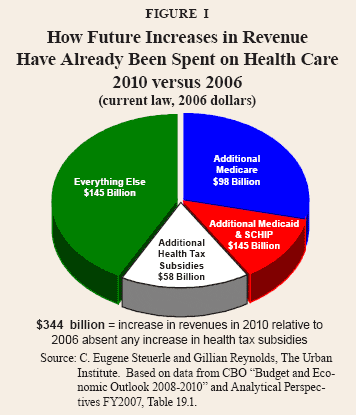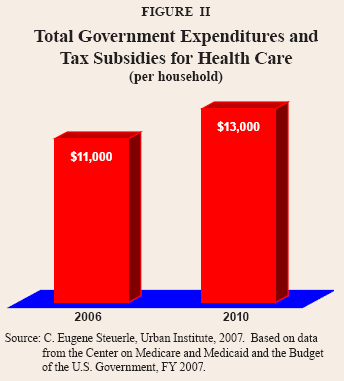Since 1975, total spending on health care in the United States has doubled, and it now comprises one-sixth of the U.S. economy, or about $2.2 trillion. By 2016, some projections show total health spending almost doubling to $4.1 trillion and consuming one-fifth of the nation's gross domestic product.
Much of the increase in health costs has been paid for through direct government expenditures and tax subsidies. The government's role in financing health care is also growing due to the recent Medicare expansion. The budget for health care will likely grow more than any other area of government this year. Recent Congressional Budget Office estimates show that the majority of the projected $344 billion increase in federal revenues in 2010 – relative to 2006 and absent additional revenues lost to tax subsidies for health – is scheduled to go automatically to cover the cost of additional health expenditures and the revenues lost to tax subsidies for health. [See Figure I.] 
Current Government Health Care Spending. Government health programs (principally Medicare and Medicaid) and tax subsidies accounted for more than half ($1.3 trillion) of total health expenditures in 2006. Government statistics also reveal:
- In 2006, total health care spending averaged $19,000 per household; about 58 percent of the total, or $11,000 per household, was in the form of government-subsidized health care;
- By 2010, inflation-adjusted government health care spending is projected to grow to an average of $13,000 per household [see Figure II];
- Health care will climb to 25.8 percent of total government outlays in 2008 and 28.4 percent in 2012.
Medicare Growth and the Government. The majority of growth in government spending on health care is due to Medicare:
- Medicare accounted for 38 percent of public spending on health care in 2005, and it has grown an average of 9.3 percent annually since 2002;
- The cost per beneficiary (Medicare and Medicaid) has continually been increasing faster than the per capita growth of the economy, and the Medicare actuaries see no end in sight.
Congress has attempted to cut reimbursements for Medicare providers, and the growth of Medicare was projected to slow to 6.5 percent this year. However, legislators have already reversed the cuts in physician payments for 2007, so the actual growth rate may be higher.
Tax Breaks for Employer-Provided Insurance. Health care spending has also grown because of tax subsidies. Tax subsidies lower the private cost of health care, but they raise the total public cost in the sense that these revenues could have been spent elsewhere. The income tax break for employer-provided health insurance alone is the largest federal tax break, and it is also the largest health subsidy in the tax or expenditure systems for the nonelderly and nondisabled. The federal government also subsidizes employer-provided insurance through a Social Security tax break, and state governments forgo income tax revenues as well. In sum, more than $250 billion in revenues each year are forgone due to tax subsidies for health insurance. These subsidies are open-ended; according to one estimate, the cost of tax preferences for health insurance will grow by $58 billion in 2010 [Figure I].
These tax breaks are not very efficient at expanding health care, nor are they distributed equitably. They tend to favor people with higher incomes, those with more expensive health plans and those living in areas with higher-than-average utilization of services to treat the same problems treated elsewhere. The exclusion of employer-provided health benefits from wages sometimes reduces the taxes of higher-income households as much as $3,000 or more, while many moderate-income taxpayers only get one-half or one-fourth of that amount – and sometimes nothing at all.
By any standard, taxpayers are not getting their money's worth: Instead of buying coverage for more people, the subsidies encourage insured people to buy higher-cost insurance, which encourages more use of high-cost health care and ultimately drives up health costs. Rising health care costs leads to more expensive insurance. Many individuals and employers simply will not pay those high insurance costs. Thus, in the end, the incremental amounts spent each year may actually be increasing – yes, increasing, not decreasing – the number of uninsured!

Flexibility to Meet the Nation's Needs. Large automatic growth in expenditures only for certain programs leaves Congress in a straightjacket, with little flexibility to determine how to allocate additional revenues to meet the most important needs of the nation. As the share of spending on health grows, the share scheduled for many other programs, such as education and children's programs, is scheduled to decline.
Within health care itself, two or three years' worth of Medicare growth could pay for a decent health insurance package for all children, and a few years' worth of growth in health insurance tax subsidies, which mainly benefit higher-earning employees, could pay for a modest health insurance tax credit for households at all income levels. Furthermore, the growth of government spending on existing health programs and tax subsidies consumes resources that might otherwise go toward achieving higher immunization rates, enhancing services for the frail elderly, expanding preventive care or increasing the budget of the Centers for Disease Control and Prevention.
Conclusion. Every year billions more are spent on health care in the United States. Most of the additional revenues generated through economic growth are now scheduled to go toward costs in existing health programs, regardless of their effectiveness in meeting the nation's health and nonhealth needs. The government's portion of spending is growing especially fast because most government health benefits are not appropriated: Spending increases automatically each year without a vote by Congress. This autopilot feature means that even when Congress and the president "cut" a little here or there from the discretionary portion of the budget, the mandatory government health care spending trajectory usually overwhelms any saving achieved. The important question is whether past government tax and spending policies can be taken off autopilot and redirected to fairly and efficiently meet the nation's needs, including the health care needs, of Americans today and tomorrow.
Eugene Steuerle, Ph.D., is a senior fellow at the Urban Institute. The opinions are those of the author and do not necessarily reflect those of the Urban Institute, its trustees or its sponsors .